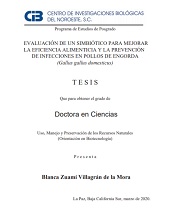Mostrar el registro sencillo del ítem
EVALUACIÓN DE UN SIMBIÓTICO PARA MEJORAR LA EFICIENCIA ALIMENTICIA Y LA PREVENCIÓN DE INFECCIONES EN POLLOS DE ENGORDA (Gallus gallus domesticus)
| dc.contributor.advisor | Ascencio Valle, Felipe de Jesús | |
| dc.contributor.advisor | PEREZ URBIOLA, JUAN CARLOS | |
| dc.contributor.author | Villagrán de la Mora, Blanca Zuamí | |
| dc.date.issued | 2020-03 | |
| dc.identifier | https://cibnor.repositorioinstitucional.mx/jspui/handle/1001/1913 | |
| dc.identifier.uri | http://dspace.cibnor.mx:8080/handle/123456789/3026 | |
| dc.description.abstract | "La industria avícola tradicionalmente ha hecho uso de antibióticos para obtener mayores rendimientos de producción y control de microorganismos patógenos, sin embargo, su uso ha sido asociado a efectos nocivos. Encontrar tratamientos alternativos que permitan obtener resultados similares a los antibióticos es indispensable, por lo que objetivo del presente estudio fue evaluar el efecto de un simbiótico sobre la eficiencia productiva, la microbiota y la estructura del intestino y órganos linfoides de pollos de engorda infectados con Salmonella Typhimurium y Clostridium perfringens. Los pollos fueron divididos en ocho tratamientos: Control; Simbiótico; Simbiótico + S. Typhimurium; Simbiótico + C. perfringens; Simbiótico + S. Typhimurium + C. perfringens; S. Typhimurium; C. perfringens; S. Typhimurium + C. perfringens. El simbiótico se administró el primer día de vida y los patógenos el 17. El bioensayo duró seis semanas, con seis muestreos con tres réplicas cada uno. Después de medir los parámetros zootécnicos, los pollos fueron sacrificados y eviscerados, tomando muestras para análisis microbiológicos e histológicos." | es |
| dc.format | es | |
| dc.language.iso | spa | es |
| dc.publisher | Centro de Investigaciones Biológicas del Noroeste, S.C. | es |
| dc.rights | Acceso abierto | es |
| dc.subject | simbiótico, microbiota, Salmonella Typhymurium, Clostridium perfringens, mucosa intestinal, bolsa de Fabricio, bazo, timo | es |
| dc.subject | synbiotic, microbiota, Salmonella Typhymurium, Clostridium perfringens, intestinal mucosa, burza, spleen, thymus | es |
| dc.subject.classification | INMUNOLOGÍA | es |
| dc.title | EVALUACIÓN DE UN SIMBIÓTICO PARA MEJORAR LA EFICIENCIA ALIMENTICIA Y LA PREVENCIÓN DE INFECCIONES EN POLLOS DE ENGORDA (Gallus gallus domesticus) | es |
| dc.type | doctoralThesis | es |
| dc.dirtesis.grado | Doctorado en Ciencias en el Uso, Manejo y Preservación de los Recursos Naturales | es |
| dc.dirtesis.disciplina | Biotecnología | es |
| dc.dirtesis.universidad | Centro de Investigaciones Biológicas del Noroeste, S.C. | es |
| dc.dirtesis.facultad | Posgrado en Recursos Naturales | es |
| dc.description.abstracten | "The poultry industry has traditionally made use of antibiotics to obtain higher performance and control of pathogenic microorganisms, however, their use has been associated with harmful effects. Finding alternative treatments that permit similar results to antibiotics is indispensable, therefore the objective of the present study was to evaluate the effect of a synbiotic mix on the growth performance, microbiota and the morphology of the intestine and lymphoid organs of broilers infected with Salmonella Typhimurium and Clostridium perfringens. The chickens were divided into eight treatments: Control; Synbiotic; Synbiotic + S. Typhimurium; Synbiotic + C. perfringens; Synbiotic + S. Typhimurium + C. perfringens; S. Typhimurium; C. perfringens; and S. Typhimurium + C. perfringens. The synbiotic was administered on the first day of life and the pathogens on the 17th. The bioassay ran for six weeks, with six samples with three replicates each. After measuring the zootechnical parameters, broilers were slaughtered and eviscerated, taking samples for microbiological and histological analysis." | es |

